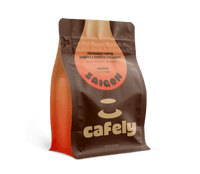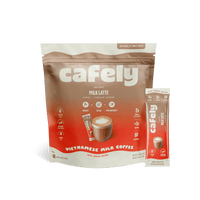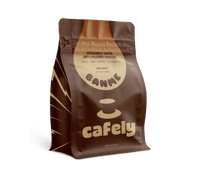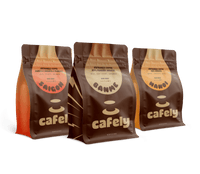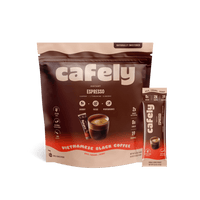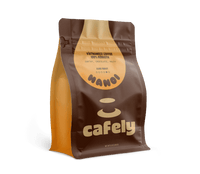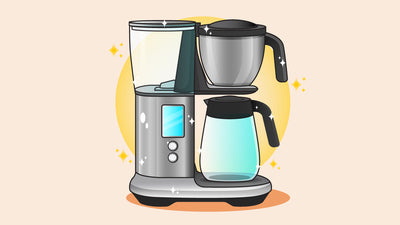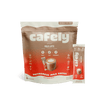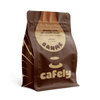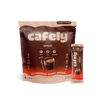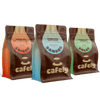You don’t have to go to a coffee shop for the perfect cup of coffee. With a little know-how — and not much effort — you can make even better coffee at home.
In this article, we’ll cover a variety of brewing methods, how to choose one that suits your lifestyle, the best coffee beans to use, and how to get incredible coffee every time.
Coffee Maker Spec Sheet: Water Ratio, Grind Size, & Portion Sizes Compared
|
Grind size |
Coffee-to-Water Ratio |
Caffeine Content Per Serving |
Brewing Time in Minutes |
Best Beans to Use |
|
|
Drip Coffee Maker |
Medium |
1:17 |
80–100 mg |
5 |
Medium- roast |
|
Pour-Over Device |
Medium |
1:17 |
90–160 mg |
3-4 |
Light to medium- light roast |
|
French Press |
Coarse or medium- coarse |
1:12 |
100–137 mg |
4-5 |
Light to medium- light roast |
|
Phin Drip Filter |
Medium- fine |
1:2 |
66–130 mg |
5-7 |
Dark roast |
|
Espresso Machine |
Fine |
1:2 |
75–150 mg |
0.5 |
Dark roast |
|
Moka Pot |
Fine |
1:10 |
75–150 mg |
3-4 |
Medium to medium- dark roast |
|
AeroPress |
Fine |
1:7 |
75–150 mg |
2-3 |
Medium to medium- dark roast |
How to Use A Coffee Maker

Making fantastic coffee at home isn't complicated, but there are a few things to know before diving in. You need to deal with coffee bean varieties, different grind levels, and multi-step brewing methods. It may sound like a lot more work than ordering a cup from your favorite coffee shop, but the results are definitely worth it.
There are many different types of coffee makers, and each one brings something unique to the table.
Drip Coffee Maker
A drip coffee maker is the most common type of coffee machine in the US. You pour water into the reservoir, add a paper filter into the basket, fill it with ground coffee, and let the machine do the rest.
The coffee machine heats the water and drips it onto the coffee grounds. In 5-10 minutes, you’ve got a pot full of hot, fresh coffee.
There are many kinds of drip coffee makers — from high-tech to minimalistic. It's important to consider each one's traits when buying one. For example, some can be prepared beforehand and programmed to brew the coffee at a set time. Others have built-in coffee grinders or take coffee pods (like a Keurig). If you're using a fast-brewing system, check out how to use Bunn coffee maker to get the best results from your machine.
Tip: While this method is pretty standard, the coffee can be, well, basic. Use high-quality coffee beans, and make sure to use the right coffee-to-water ratio — it won't taste good if it's too weak.
Drip Coffee Specs:
- Grind Size: Medium
- Brew Time: 5 minutes
- Suggested Coffee: DaLat Coffee
- Suggested Drink: Hot with homemade creamer
Step-By-Step Instructions:
- Place a paper filter into the basket and fill the water reservoir with filtered water to the fill line.
- Measure 14 g of coffee beans per serving.
- Grind the coffee coarsely — it should have the same texture as sea salt.
- Place the coffee into the filter, turn on your machine, and wait for the coffee to brew.
Pour-Over Device
A pour-over device works in a similar way to a drip coffee maker, but many people prefer it because it gives them more control over the results. Of course, this can be a good or bad thing. It takes some practice and experimentation to get it right. However, once you understand the process, you can tweak it to perfection.
It’s a simple process, in theory — just add a filter to the device and fill it with ground coffee. Place it on a cup and slowly pour water over the grounds. The trick is that you control the variables that make or break a cup of coffee: the coffee to water ratio, grind size, brew time, brew temperature, and agitation. Experiment with each one and see how the changes affect the final cup.
When buying a pour over, you’ll need to consider the shape and the material it’s made of. Conical ones give better flavor, but flat-bottomed pour overs are easier to use (there’s more to it than just pouring the water!). They also come in plastic, ceramic, steel, and glass — and each has pros and cons.
Professional Tips: Bloom the coffee first by pouring a little hot water onto the grounds, allowing gas to escape. Then, add the rest of the water.
Take a look at our Chemex brewing guide or our Hario V60 brewing guide for more info.
Pour-Over Specs:
- Grind Size: Medium
- Brew Time: 4 minutes
- Suggested Coffee: SaiGon OG
- Suggested Drink: Hot with a splash of cream
Step-By-Step Instructions:
- Place a paper filter into your pour-over device. Pour in some hot water to wet the filter and dispose of any excess water that runs through into the glass/cup.
- Measure 15 g of coffee beans per serving for a Chemex or 25 g of coffee beans for a Hario V60.
- Grind the coffee coarsely — it should have the same texture as sea salt.
- Place the coffee inside the filter and bloom with a small amount of hot filtered water.
- Wait 45 seconds, and then add the remaining water in a slow, gentle, circular motion.
French Press
A French press, also known as a plunger pot or press pot, uses an immersion-style brewing technique. Brewing coffee in a French press creates a well-balanced, smooth cup of coffee.
Place the ground coffee and hot water into the French press and wait 4-5 minutes for the coffee to brew. Then, slowly press the plunger to filter the coffee, pour, and enjoy.
You can also make cold brew coffee in a French press, adding to its usefulness.
French presses come in many sizes, though the larger ones are more versatile since you can still make a small amount. They're usually made of glass, but you can also find ones made of metal or clay. Personal experience dictates metal (the glass ones break too easily), but glass is less likely to hold onto flavors and aromas from previous brews.
Professional Tips: Take advantage of this method’s ability to draw out the complex flavors by using a high-quality, flavorful bean. Set a timer so you don’t let it brew for too long, as it will become over-extracted and taste bitter.
French Press Specs:
- Grind Size: Coarse
- Brew Time: 4 minutes
- Suggested Coffee: DaNang Coffee
- Suggested Drink: Hot black or French Press Iced coffee
Step-By-Step Instructions:
- Measure around 17 g of coffee beans per serving — exactly how much coffee you need depends on the size of your French press.
- Grind the coffee coarsely — it should have the same texture as sea salt.
- Add the coffee to the bottom of the French press and top with filtered water. Fully retract the plunger of the French press lid and place it on top of the glass.
- Leave the coffee to brew for four minutes before pushing down on the plunger to filter the coffee.
Related: Best Coffee to Use in a French Press (Roast, Grind, Species, & Origin)
Phin Drip Filter
A phin filter is the best way to make authentic Vietnamese coffee, whether it's arabica or robusta beans. Position it on your cup, fill the phin chamber with ground coffee, pour hot water to the fill line, and wait for it to brew. It’s traditionally served with sweetened condensed milk and ice.
These come in different sizes and styles, so consider the number of servings you'll typically be making. Most are stainless steel or aluminum, and some have a twist-on filter, which can help you achieve optimal extraction.
Phin Filter Specs:
- Grind Size: 7 minutes
- Brew Time: Medium-fine
- Suggested Coffee: HaNoi Coffee
- Suggested Drink: Vietnamese iced coffee
Step-By-Step Instructions:
- Measure around 14 g of coffee beans per serving — exactly how much coffee you need depends on the size of your phin filter.
- Grind the coffee finely — it should have the same texture as sand.
- Assemble the phin filter on top of your cup.
- Add the coffee grounds into the chamber and apply pressure to the gravity press to distribute the grounds evenly.
- Bloom the coffee with a small amount of hot filtered water and wait 45 seconds.
- Add the remaining water and wait for the coffee to finish brewing.
Espresso Machine
You don’t have to go to a coffee shop for an amazing espresso — you can make your own at home!
With an espresso machine, you add ground coffee to the portafilter and tamp it down. Then, lock it into the espresso machine and wait for the hot water to run through the coffee grounds. With a few shots of espresso, you have a world of options when it comes to coffee drinks.
Some machines come with the steaming and frothing wand, which is almost a necessity. You can buy smaller ones that require you to add the correct amount of water each time or larger ones that have water containers attached and measured for you. You can get as fancy and as expensive as you want, but the main thing is to buy a good brand that will give you consistent, quality shots.
Professional Tips: There’s a theory that a shot of espresso “expires” after ten seconds, but that’s been largely debunked. However, according to New Grounds, science shows that it becomes thinner after three minutes and more bitter after ten minutes. So, while you don't have to chug it, don't let it sit for too long.
Espresso Machine Specs:
- Grind Size: Fine
- Brew Time: 1 minute
- Suggested Coffee: HaNoi beans or grounds
- Suggested Drink: Breve Coffee, Americano
Step-By-Step Instructions:
- Turn your espresso machine on and wait for it to heat up — this can take up to 30 minutes.
- Measure 9 g of coffee beans for a single shot or 18 g for a double shot.
- Grind the coffee finely — it should have the same texture as sand.
- Add the coffee to the portafilter and tamp it down evenly.
- Lock the portafilter into the machine and extract the shot over 25-30 seconds.
Moka Pot
A moka pot is a great way of brewing something similar to espresso without an expensive espresso machine. The coffee is very concentrated but not quite strong enough to be espresso. But it certainly makes a decent substitute.
Add ground coffee and water to your moka pot and place it on the stove. Once it starts brewing, turn down the heat and let it finish.
Moka pots are stainless steel or aluminum and easy to clean, but a little finicky to master. Size matters here, as you can’t fill it half way and make coffee, so don’t buy one that’s too big.
Professional Tips: Don’t walk away from the stove (besides being dangerous, personal experience says the plastic handles can melt off if left unattended and forgotten about), and don’t use coffee that’s ground too fine. It can clog the filter and cause a dangerous amount of pressure to back up. More importantly, make sure you’re cleaning your stainless steel coffee pot thoroughly to prevent buildup that could affect the flavor or safety of your brew.
Moka Pot Specs:
- Grind Size: Fine
- Brew Time: 4 minutes
- Suggested Coffee: HaNoi
- Suggested Drink: Cuban coffee (add 3-4 teaspoons of sugar to the brewed coffee; we suggest brown sugar)
Step-By-Step Instructions:
- Measure around 6 g of coffee beans for each shot — exactly how much coffee you need depends on the size of your moka pot.
- Grind the coffee finely — it should have the same texture as sand.
- Pour water into the bottom chamber, add the filter basket, and fill it with ground coffee.
- Screw on the top of the pot and place on the stove over a medium heat.
- When the coffee begins to make a gurgling noise, reduce the heat to the lowest setting and wait for 1-2 minutes until the brewing process is complete.
AeroPress
Using an AeroPress feels like a cross between an espresso machine and a French press. Place a filter over your cup and add the ground coffee and water to the AeroPress. Leave the coffee to brew for 30 seconds, and then press the plunger down to extract the coffee straight into your cup.
Originally, there was just one, but now there are plenty of options. And if you're not a fan of paper filters, you can buy a reusable metal one. One of the best things about an Aeropress is its portability. If you travel or camp often but don't want to be stuck with gross coffee, this could be your best friend.
Professional Tips: Some people swear by the inverted method. Place the plunger inside the chamber. Set it up so the open side is facing up. Rinse the filter and place it in the cap. Put the ground coffee into the chamber, then add water just off a boil and stir. Put the lid on and wait two minutes. Place your cup on the top and flip it over. Give it a swirl and gently press down on the plunger (slow is better!). If you find this method too strong, dilute it next time with a little more water.
AeroPress Specs:
- Grind Size: Fine
- Brew Time: 3 minutes
- Suggested Coffee: SaiGon OG
- Suggested Drink: Use it to replace espresso in any espresso-based drink, like a latte
Step-By-Step Instructions:
- Measure 11-15 g of coffee beans per serving — exactly how much coffee you need depends on the size of your AeroPress.
- Grind the coffee finely — it should have the same texture as sand.
- Assemble your AeroPress and place it on top of your cup.
- Fill the chamber with ground coffee and water.
- Stir the coffee for 10 seconds, then leave to sit for 30 seconds.
- Attach the plunger and press down to filter the coffee.
Cleaning & Maintaining Your Coffee Maker
You need to stick to a regular cleaning routine to make everything last longer and keep your coffee tasting great. Cleaning your coffee maker is quicker and easier than you probably think and helps lengthen its life. It’s also crucial from a health perspective — coffee makers can breed bacteria and become moldy if not cleaned often.
Descale your coffee or espresso machine to clean the inside and remove unwanted mineral and oil build-up. You only have to do this once every few months, and it only takes about half an hour, so it’s not a big deal.
To keep your coffee maker looking new, wash the removable parts daily. Clean the reservoir, filter basket, carafe, and showerhead by hand in warm, soapy water and leave to dry.
What Kind of Coffee Is Best for Each Coffee Maker?

It’s easy to assume that you can grab whatever ground coffee looks interesting and use it in your coffee maker. While yes, this is possible, this is not how you get incredible coffee.
Not only do you have to choose the right kind of coffee beans, but you also have to decide on the right grind side for the best results.
To take away the mystery and make things a little easier for you, here’s a breakdown of which type of coffee you should use in your coffee maker.
Selecting Grind Size
Although you can buy ground coffee, we always recommend buying whole beans and grinding them just before you brew your coffee. This will give you the best flavor every time.
Each brewing method requires a different grind size, and straying too far from that can result in a horrible cup of coffee. In some cases, it could cause problems with the machine.
Common coffee grind size issues:
- Coffee That’s Ground Too Coarse — Your coffee will be under-extracted and weak
- Coffee That’s Ground Too Fine — Your coffee will be over-extracted, bitter, and chalky
The longer the ground coffee beans are exposed to water, the coarser the grind needs to be.
For example, immersion methods like the French press and cold brew require the beans to steep in the water, allowing the coffee’s compounds to be extracted. They need to be coarsely ground so the coffee doesn’t become over-extracted.
Espresso machines, the phin filter, and moka pots work quickly, forcing the water through the coffee grounds in a short amount of time. In order to have a greater surface area exposed to the water, the coffee beans should be properly ground.
Selecting The Type of Coffee
Always use fresh, high-quality beans for the best coffee. Air, moisture, heat, and light will damage your coffee beans, but you can keep them safe by storing them in an opaque air-tight container at room temperature.
If you're used to generic or large-chain coffee beans, try some from a specialty shop instead, and you'll definitely notice the difference. You'll discover many new types of beans, aromas, and flavors that you never would have come across otherwise.
You can also buy coffee online. Our SaiGon OG (peaberry, robusta, and arabica blend) is a fantastic coffee to start with as it offers the best of both worlds — it’s bold and balanced, as well as strong and velvety.
DaNang blend (robusta and arabica) is another great all-rounder. It has a balanced profile from the arabica beans and a caffeine punch from the robusta beans. It has delicious flavor notes of citrus, maple syrup, and toasted nuts, making it ideal if you’re looking for something more flavorful than what you’re used to.
Both are incredibly versatile and are excellent in any coffee machine.
Of course, some beans do work better with certain brewing methods than others, so here’s a look at the different varieties.
Arabica Coffee
Arabica coffee beans have a slightly sweet flavor profile with subtle floral notes and wonderful berry aromas. The fruity acidity and lack of bitterness make it suitable for almost all palates.
A cup of coffee made with arabica beans will be sweet, smooth, and deliciously aromatic. You’ll notice notes of nuts, chocolate, sugar, caramel, or fruit — or a combination of these flavors.
Robusta Coffee
Robusta coffee beans have a bold and nutty flavor profile with little to no acidity. It’s an excellent choice if you enjoy your coffee strong and you love complex flavors.
A cup of coffee made with robusta beans will have a deep, bold mouthfeel with flavor notes of earth and wood unlike the arabica beans. You’ll notice hints of whiskey, almonds, and dark chocolate in every sip and may even experience notes of peanuts in the aftertaste.
Pro Tips for Brewing Coffee in a Coffee Maker
Making amazing coffee at home is truly an art form. To become a brewing master and make incredible coffee every single time, follow our expert tips:
- Always use fresh coffee beans — Check the use-by date on your coffee beans to make sure they’re worth using and make sure to store them properly.
- Grind your own coffee — Grind your own coffee beans immediately before brewing coffee.
- Use the correct grind — Overly fine coffee grounds will result in bitter coffee, while overly coarse coffee grounds will result in flavorless coffee. Make sure to grind your beans exactly fine to avoid complications.
- Use filtered water — Water is one of the two basic ingredients in coffee, and you need the best-filtered water for top results.
- Brew at the right temperature — Check the recommended temperature on your coffee bean packaging and adjust your machine’s settings for the best result.
- Experiment with different beans — Explore the exciting world of specialty coffee beans until you find your favorite brew.
- Use the right ratio of coffee to water — Follow the manufacturer’s guidelines to determine the correct coffee-to-water ratio and experiment until you get it perfect.
How to Choose a Coffee Maker
Your coffee maker will become part of your daily routine, so it’s essential you buy the right one.
Below, you'll find some important things to consider when choosing a brewing method:
- Convenience — Which brewing method fits in with your daily routine and preferences? How do you like your coffee and how long are you willing to spend making it?
- Brew Size — Do you want to make individual cups of coffee or do you want to make coffee in larger amounts? Some coffee makers do both.
- Machine Dimensions — You need to make sure your chosen machine will fit in the space you’ve set aside for it. Some coffee makers can be surprisingly large!
- Timing Options — Do you want to wake up to freshly brewed coffee? Some machines have built-in timers, allowing you to brew coffee before you even get out of bed.
- Built-In Grinder — Some coffee makers have built-in grinders that grind the beans for you just before brewing. This is a great feature if you’re looking for a hands-off experience.
- Extra Features — There are smart coffee makers that come with all kinds of interesting features: audible alerts, automatic brewing cycles, keep-warm options, brew size adjustments, flexible water temperatures, etc. Stylish models like Smeg coffee makers also offer retro-inspired design without sacrificing functionality.
But if you are pressed for time, you can always learn how to make coffee without coffee maker. You can use instant coffee to make a quick cup, for example, or drip coffee bag if you want it brewed.
FAQs: How to Use a Coffee Maker

1. Can I use tap water in my coffee maker?
Yes, you can use tap water in your coffee maker, but we recommend filtered or bottled water for the best results. The mineral content and quality of tap water varies from area to area and greatly impacts the flavor of your coffee.
By using filtered or bottled water, you’ll get a great-tasting cup of coffee every time and won’t experience the mineral build-up in your coffee machine that you would if you used tap water.
2. How often should I clean my coffee maker?
You should clean the removable parts (carafe, water reservoir, showerhead, and filter) by hand in warm soapy water after each use. Leave to air dry before reassembling your coffee maker.
To keep it working smoothly, descale your coffee maker once every 3-6 months. Exactly how often you need to descale it will depend on how often you use it and how hard your water is.
3. What is the best temperature for brewing coffee?
The best temperature for brewing coffee is 195-205°F. The exact temperature depends on the type of coffee beans and brewing method. Getting this right is crucial if you want to make a cup of good coffee that’s rich in flavor and well-extracted.
Many coffee makers, such as drip coffee makers and espresso machines, handle the temperature for you. Other coffee makers, like pour-over devices and phin filters, require you to get the temperature right yourself.
4. Can I keep my coffee warm in a coffee maker?
It’s not a good idea to keep your coffee warm in a coffee maker because it degrades the quality of the coffee. You should always pour your coffee immediately after it’s finished brewing for the best results.
If you need to keep your coffee warm, let it sit on a warming plate or pour it into a thermal carafe. This way, your coffee stays at the right temperature, and you won't risk burning it.
5. How do I know how much coffee to use?
The ratio of coffee to water differs according to the brewing method. Start by using the suggested amounts in the manufacturer’s instructions, or check out our suggestions above if there aren’t any.
From there, you can experiment with different ratios until you find your perfect brew. Use less water or more grounds if you want your coffee to be stronger and more water or fewer grounds if you prefer your coffee to be weaker.
Related: How Much Coffee Do I Use Per Cup?
6. Is it okay to leave water in the coffee maker overnight?
You should avoid leaving water in your coffee maker overnight and always add fresh water before each use. Adding fresh water just before brewing will give you the best-tasting coffee every time. You really can taste the difference!
7. Can I use different types of coffee in my coffee maker?
Yes, most coffee makers can generally handle different types of coffee. If you want to be extra safe, check the manufacturer’s guidelines for your coffee maker and the recommendations on the back of the coffee bean packet.
Keep in mind that the variety of coffee beans isn’t the only thing that affects the brew. The grind size, quality of the coffee beans, brewing method, and brewing time all impact how your coffee tastes.
8. What should I do if my coffee tastes bitter?
There are several reasons your coffee could taste bitter:
- Too much coffee. You could be using too much coffee. Try using less and try again.
- Overly fine coffee. You could be grinding your coffee too fine. Try using a coarser grind — around the same size as coarse sand.
- The water is too hot. You could be brewing your coffee at too high a temperature. Lower the temperature and try again.
9. How can I make my coffee less acidic?
If your coffee is too acidic, try brewing with a darker roast coffee bean. Dark roast beans are generally less acidic than medium and light roasts.
Alternatively, use the cold brew method to make your coffee. Cold brew tends to be smoother and less acidic than traditional coffee brewing methods made with hot water.
10. Can I use pre-ground coffee in my coffee maker?
Yes, using pre-ground coffee is a great way to make home brewing even quicker and easier. Although it’s convenient, pre-ground coffee won’t deliver the best results.
For an incredible flavor and aroma, we recommend freshly grinding your coffee immediately before brewing.
